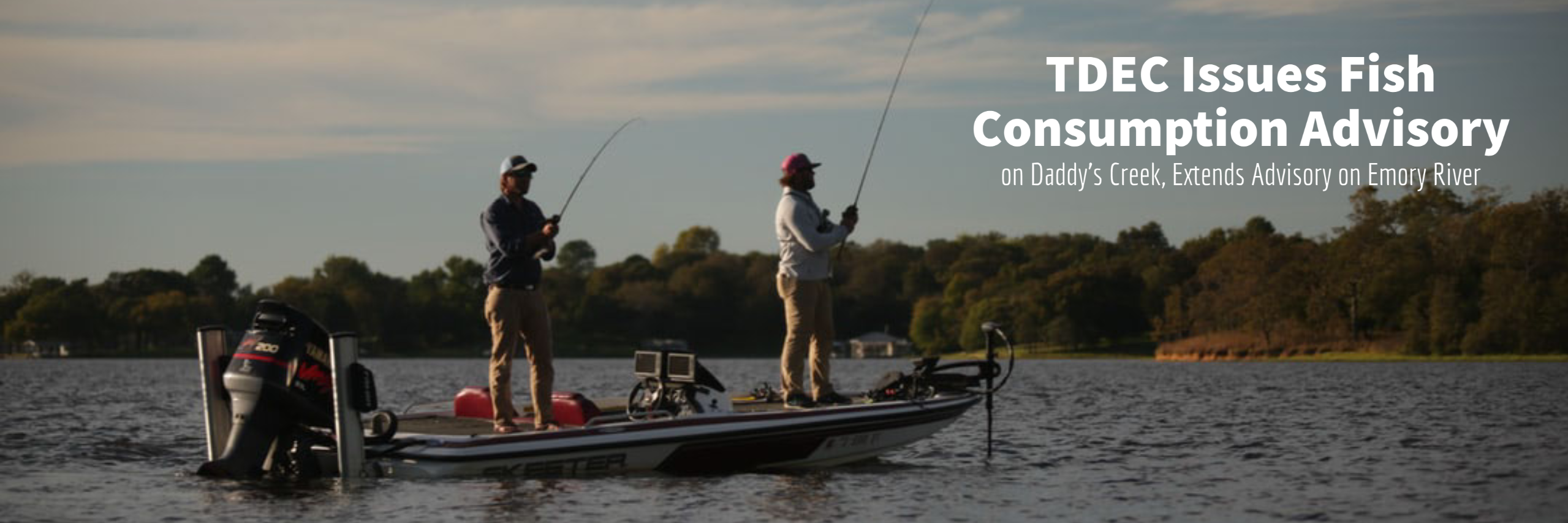Re-blogged from TDEC press release issued on July 1, 2020

The Tennessee Department of Environment and Conservation (TDEC) today announced a 6.7-mile extension of the existing precautionary fish consumption advisory due to mercury on the Emory River in Morgan County. Additionally, a new precautionary advisory due to mercury in smallmouth bass is being issued for a portion of Daddy’s Creek in Morgan and Cumberland counties.
Obed River fish were also tested on multiple occasions and were not found to have elevated levels of mercury.
“We provide these advisories so the community can make informed decisions about whether or not to consume the fish they catch,” TDEC Deputy Commissioner Greg Young said. “Unlike ‘do not consume’ advisories that warn the general population to avoid eating fish from a particular body of water altogether, precautionary fish consumption advisories are specifically directed to sensitive populations such as children, pregnant women, nursing mothers and those who may eat fish frequently from the same body of water.”
In a 2006 statewide screening of Tennessee rivers and lakes, Emory River was identified as a waterbody where mercury levels in fish were elevated and an advisory was issued in 2007. Additional studies by TDEC and the Tennessee Valley Authority indicated these elevated mercury levels in fish extended further upstream than previously thought.
Today’s action expands the advisory 6.7 miles upstream to the mouth of the Obed River. The Emory advisory, which is for all fish species, now extends from U.S. Hwy 27 (mile 12.4) upstream to the mouth of the Obed River at mile 28.4.
The Daddy’s Creek precautionary advisory is for smallmouth bass only and will extend from its mouth on the Obed River upstream to Interstate 40 near mile 20. This section includes the portion of the stream that was designated by Congress as a National Wild and Scenic River and includes the portion within Catoosa Wildlife Management Area.
TDEC advises that pregnant or nursing mothers and children avoid eating the fish species included in the advisory and that all others limit consumption to one meal per month. Other recreational activities such as boating, swimming, wading, and catch-and-release fishing carry no risk.
In the last 11 years, the Tennessee Valley Authority (TVA) collected fish in the Emory River at mile 22 (Deermont Road) in 2009, 2012, 2016, and 2019. TDEC also sampled this station in 2013. Additionally, TDEC sampled the Emory upstream at mile 27.7 (Nemo Bridge) in 2009 and 2013. Daddy’s Creek at mile 2.3 (Devils Breakfast Table) was sampled by TDEC in 2009, 2013, and 2019.
These studies documented that in fish from the Emory River, plus smallmouth bass in Daddy’s Creek, mercury levels were above the trigger currently used by the department. This trigger, 0.3 mg/kg (parts per million), was jointly recommended by both the U.S. Environmental Protection Agency and U.S. Food and Drug Administration.
In conjunction with these studies, Obed River was also tested at Potters Bridge (mile 20.8) in both 2009 and 2019. Although smallmouth bass collected in the Obed were of similar size to those from Daddy’s Creek, mercury levels were considerably below the 0.3 mg/kg trigger used for advisories. It is not clearly understood why there is such a significant difference in contaminant levels between these two otherwise similar streams.
TDEC considers the source of mercury in both the Emory River and Daddy’s Creek to be atmospheric deposition. According to the EPA, atmospheric deposition due to the global burning of coal is the most frequent reason for elevated levels of mercury in fish. TDEC will post warning signs at public access points and will work with the Tennessee Wildlife Resources Agency and the U.S. National Park Service to communicate this information to the public.
About Fish Consumption Advisories
The Tennessee Water Quality Control Act identifies the commissioner of the Department of Environment and Conservation as having the authority and responsibility to issue advisories for either water contact hazards like pathogens or excessive health risks due to the accumulation of contaminants in fish or shellfish. Tennessee’s General Water Quality Criteria provide additional guidance regarding the conditions under which advisories may be warranted.
There are two types of fish consumption advisories issued by TDEC based on the levels of contaminants present in fish tissue. “Do not consume” fishing advisories are issued when levels of contaminants in fish tissue would represent a threat to the general population. Precautionary advisories are issued when contaminant levels are lower but would still pose a risk to sensitive subpopulations such as children, pregnant women, nursing mothers and those who eat fish frequently from the same body of water.
According to the U.S. Environmental Protection Agency, mercury is a naturally occurring element that can be found throughout the environment. Human activities have caused the amount of mercury in some areas to increase. The primary way people in the U.S. are exposed to mercury is by eating fish containing methylmercury, a toxic form of mercury that accumulates easily in organisms.
Where new advisories have been issued, TDEC will immediately begin the process of putting up signs at primary public access points. TDEC works in partnership with the Tennessee Wildlife Resources Agency to communicate information about fishing advisories.
For a complete listing of Tennessee’s current fishing advisories plus additional information about the advisory issuance process, visit:
https://www.tn.gov/content/dam/tn/environment/water/documents/water_fish-advisories.pdf
An EPA website has additional information about mercury at:
http://www2.epa.gov/fish-tech/epa-fda-advisory-mercury-fish-and-shellfish.


